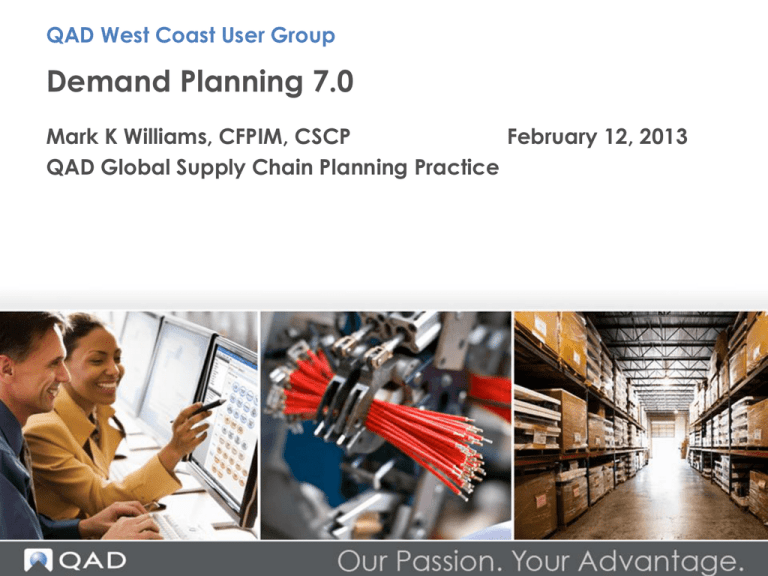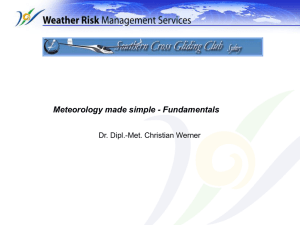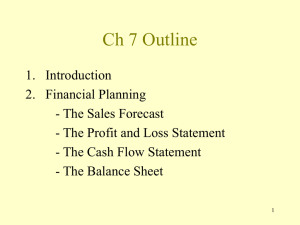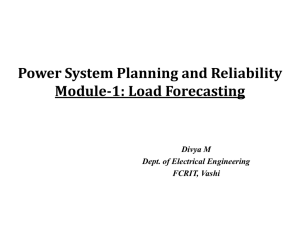Learn more about QAD`s new acquisition
advertisement

QAD West Coast User Group Demand Planning 7.0 Mark K Williams, CFPIM, CSCP February 12, 2013 QAD Global Supply Chain Planning Practice Introduction Agenda • Introduction to DynaSys • Introduction to forecasting • Demand Planning 7.0 attributes • Easy On Boarding 2 Introduction to DynaSys 3 Introduction to DynaSys The Mission of DynaSys “Offer to our customers, a Comprehensive and Effective Planning Solution dedicated to Supply Chain Excellence, benefiting from our 27 years of expertise.” Durability Expertise Partnership Loyalty A Few DynaSys Customers 5 Introduction to DynaSys Global Customers With Multiple Sites Ipsen : 110 sites Essilor : 18 sites Everris : 32 sites Mapa/Spontex : 27 sites Baxter Healthcare : 25 sites Introduction to DynaSys DynaSys Customer Base Luxury 14% Industry 14% Retail 19% Food & Beverage 39% Pharma 14% 7 Introduction to DynaSys Master Planning Network & Inventory Optimisation S U P P Procurement L Planning I E R Not Yet! Production Planning Distribution Planning Demand Planning C U S T O M E R Operational Tactical Strategic Supply Chain Planning Suite Procurement Production Distribution Sales 70 60 50 Upper Limit Forecast Lower Limit 40 30 20 10 0 1st Qtr 2nd Qtr 3rd Qtr 4th Qtr Introduction to Forecasting Importations Corrections Calculation history Life cycle Metrics & validation collaboration Forecasts Detailed monthly forecasting process 9 Introduction An Industry Supply Chain Physical Supply Chain Natural Resources Suppliers Production Distribution Retail Information Supply Chain Consumers Introduction What is a Forecast? An estimate of future demand. A forecast can be constructed using quantitative methods, qualitative methods, or a combination of methods, and it can be based on extrinsic (external) or intrinsic (internal) factors. Various forecasting techniques attempt to predict one or more of the four components of demand: cyclical, random, seasonal, and trend. APICS Dictionary 4 Components of Demand Seasonal Trend Daily (fast food) Annually (snow plows) New Product New! Follows Economy Mature Product Outlier Random Cyclical Introduction Forecasts Are More Accurate When Aggregated How Many Brown, Size 10 Shoes Will We Sell Thursday? Not Very Accurate – Just a Wild Guess How Many Shoes Will We Sell This Month? Better Chance Of Being Accurate – Can Use Data Introduction Forecasts Become Less Accurate With Time 70 60 50 Upper Limit Forecast Lower Limit 40 30 20 10 0 1st Qtr 2nd Qtr 3rd Qtr 4th Qtr Introduction To Improve Forecast Accuracy, Involve Your Customers & Major Stakeholders It All Sounds Good, But…. 16 Introduction Sr. Managers Meet To Discuss Forecasting 17 Introduction Senior Management Discussion Overheard… • “We have 42,000 SKU’s and a limited budget for personnel to do forecasting. How do we get the most bang for the buck??” • “Sales, Marketing & Demand Planning all think they are better at forecasting promotions. Who is right?” • “My old company kept 2 weeks of Safety Stock on hand for each item. Isn’t that enough?” • “Which products are behind budget?” • “The forecast is always wrong, why bother?” 18 Senior Management Overheard…. “The Forecast Is Always Wrong, Why Bother?” 19 Why Forecast? Forecasting Rule #1 The Forecast Is WRONG Why Forecast? Why Forecast? • To anticipate change - Promotions New products Product retirements Customer buying habits • To anticipate inventory and capacity demands • To procure materials in a timely manner • To project costs of operations into budgeting processes & manage cash flow Why Forecast? The Quandary Supplier Lead Time East Coast DC Overseas Supplier Customer Lead Time Item Scanned Delivery Expected 22 Why Forecast? Companies That Do Not Adequately Forecast: • Often have employees that work overtime for months, followed by layoffs • Are poor users of manufacturing capacity • Are unable to fulfill “surprise” customer orders • Face huge expediting charges • Have excessive inventory write-offs • Have the dreaded combination of a poor customer service level and too much inventory! • Disappoint customers by not responding to promotions on time Introduction Out of Stock Rates Double on Promoted Items Average On-Shelf Availability Levels Frozen Pizza 75.3% 90.1% 89.5% Soft Drinks 86.1% Salty Snacks 85.8% Cookies & Crackers 95.0% 88.7% Milk 85.1% Total 70% Source: Stax, Inc. Store Audits 94.0% 94.0% 79.4% Beer 93.9% 75% 80% 85% Promoted Items 96.8% 92.7% 90% All Items 95% 100% Why Forecast? Value Proposition and ROI • Reduced costs - Inventory reductions 8-10% in 6 months, 12-70% over 2-3 yrs - Reduced obsolescence and inventory write-offs 30-50% - Total cost reductions 1-2% • Improved Performance - On-time delivery to customers improvement 10-40% Plant efficiency improved between 2 and 33% Improvement in forecast accuracy – 5-20% Improved profitability 1-3% Source: IIF and other industry sources 25 Senior Management Overheard…. “We have 42,000 SKU’s and a limited budget for personnel in forecasting. How do we get the most bang for the buck??” 26 Overcoming Limited Resources DP 7.0 Answers…. • • • • • • Isolating importation errors Identification of items behaving badly Identification and correction of historical anomalies Superior Forecast Engine ABC Analysis to separate the critical from the trivial Multi-level forecasting 27 QAD Demand Planning 7.0 Statistical Forecasting Interface C o n t r o l s Graphs Excel Like Grid Collaborative Messages S h o r t c u t s Overcoming Limited Resources Isolating Importation Errors 29 Introduction Importation & Correction • • • When importing data, problems can occur DP 7.0 makes it easy to identify problems that the user can fix DP 7.0 automatically highlights items with high forecast error – major time saver 30 Isolating Importation Errors Identifying Import Problems 1 3 1. Click items without standard cost 2. Select Unit Conversion Issues 3. The list of 30 items appears Fix a problem once, & it is fixed permanently 2 31 Isolating Importation Errors Identifying Import Problems 1 2 3 32 Overcoming Limited Resources Identification Of Items Behaving Badly 33 Identification of Items Behaving Badly Last Month’s Alerts Highlight Forecast Problems Last Month’s Forecast Was Very Wrong – User Should Review 34 Identification of Items Behaving Badly Modifying Alert Parameters • Deviation Gap set at 10% will generate no alert • Change Deviation Gap to 5% generates an alert 35 Overcoming Limited Resources Identification And Correction Of Historical Anomalies 36 Identification & Correction of Historical Anomalies Why Modify History? • Forecasts are built on pattern recognition • What if your sales history included: - Extraordinary demand caused by a competitor’s stockouts? - A weather driven surge or absence of demand? - A drop in orders caused by your prolonged stockout? - Would you want the future to reflect that past? • DP 7.0 provides statistical boundaries that help identify these anomalies, allowing you to accept or modify them 37 Identification & Correction of Historical Anomalies Outliers In Sales History 38 Identification & Correction of Historical Anomalies Options for Outliers A. Item looks suspicious B. Modify history C. Accept history Actual History Modified History Suspicious Quantity Modification Validation 39 Overcoming Limited Resources Superior Forecast Engine 40 Superior Forecast Engine Forecast Pro • Method used to select the “best fit” time series forecasting techniques for your data • Judged to be one of the most accurate in the world • There are over 30 other forecasting methods available including: - Curve Fitting Exponential Smoothing Regression New Product Lifecycle • One size DOES NOT fit all! Overcoming Limited Resources ABC Analysis To Separate The Critical From The Trivial 42 ABC Analysis To Separate The Critical From The Trivial ABC Inventory Management • First noted by Vilfredo Pareto • Items are classified as: - A items (fastest movers) • 20% = 80% of sales or usage - B items (middle-range movers) • 30% = 15% of sales or usage - C items (slow movers) • 50% = 5% of sales • Focus on fast moving items • Useful in many applications - In forecasting, where we want to keep our attention ABC Analysis To Separate The Critical From The Trivial Tighter Alert Parameters For “A” Items • Deviation Gap set at 10% will generate no alert • Change Deviation Gap to 5% generates an alert 44 ABC Analysis To Separate The Critical From The Trivial ABC Classification A=80% 9 I t e m s ABC Analysis To Separate The Critical From The Trivial ABC Classification A=60% 6 I t e m s Overcoming Limited Resources Multi-Level Forecasting 47 Multi-Level Forecasting Why Not Forecast At The Item Level? • • • • Number of SKU’s Aggregation improves accuracy Forecasting resources Collaboration 48 Multi-Level Forecasting Bottom Up – Top-Down Forecasting Product Group 49 Multi-Level Forecasting Determine Difference Lower & Upper Forecasts Item XR-24 XR-34 :: :: :: Total XR PG Total BH PG Total TW PG Total Business Unit 1 Total Business Unit 2 Total Company Forecast (Units) 2,876 4,578 91,684 276,908 39,489 Corporate Sales Forecast Percent Difference Cost $ 2.98 $ 4.98 $ $ Dollar Forecast 8,570.48 22,798.44 $ $ $ 1,127,715.66 3,465,098.00 1,975,843.00 $ 6,568,657 $ $ 3,972,805 10,541,462 $ 12,000,000 13.84% Multi-Level Forecasting Revised Forecast Item XR-24 XR-34 :: :: :: Total XR PG Total BH PG Total TW PG Total Business Unit 1 Total Business Unit 2 Total Company Forecast (Units) 2,876 4,578 Original Forecast $ 8,570.48 $ 22,798.44 Revised Forecast $ 9,756.31 $ 25,952.88 91,684 276,908 39,489 $ 1,127,716 $ 3,465,098 $ 1,975,843 $ 1,283,749 $ 3,944,536 $ 2,249,225 $ 6,568,657 $ 7,477,510 $ 3,972,805 $ 10,541,462 $ 4,522,490 $ 12,000,000 Senior Management Overheard…. “Sales, Marketing & Demand Planning all think they are better at forecasting promotions. Who is right?” 52 Forecasting Promotions Collaboration in the Demand Planning Process Marketing Input Customer Input Sales Input Statistical Forecast Demand Plan New Product Development Forecasting Promotions DP 7.0 Answers • Enable Collaboration • Retain each collaborators input • Measure each collaborators accuracy 54 Forecasting Promotions Original, Non-Promotional Forecast Original Forecast 27,271 55 Forecasting Promotions 1st Collaborator – Marketing Marketing Forecast 35,000 56 Forecasting Promotions 2nd Collaborator - Sales Sales Forecast 60,000 57 Forecasting Promotions 3rd Collaborator – Demand Planning DP Forecast 45,000 58 Forecasting Promotions When Forecasting Promotions • Each collaborator inputs their forecast • A predefined hierarchy determines which forecast has precedence in determining the final forecast • All forecasts are stored in the system • After the promotion the system can determine which of the forecasts was the most accurate 59 Senior Management Overheard…. “My Old Company Kept 2 Weeks Of Safety Stock On Hand For Each Item. Isn’t That Enough?” 60 Calculating Safety Stock How Do You Determine Safety Stock Levels? Production Qty = 1 Month Average Safety Stock = 2 Weeks Part No. Forecast Actual Jan Feb Mar Apr May Jun Total 98 96 103 99 105 99 600 98 96 103 99 105 99 600 Average 100 100 • Based on producing 1 months average sales and the “2 Week Safety Stock” philosophy, is the amount of inventory appropriate? Could it be improved? 61 Calculating How Do You Determine Safety Stock Levels? Production Qty = 1 Month Average Safety Stock = 2 Weeks Part No. Forecast Actual Jan Feb Mar Apr May Jun Total 98 96 103 99 105 99 600 285 40 220 30 10 15 600 Average 100 100 • Like the previous example, the forecast & actual totaled 600 for six months • Based on producing 1 months average sales and the “2 Week Safety Stock” philosophy, is the amount of inventory appropriate? Could it be improved? 62 Calculating Safety Stock How Do You Determine Safety Stock Levels? Part No. Forecast Actual Jan Feb Mar Apr May Jun Total 98 96 103 99 105 99 600 98 96 103 99 105 99 600 Average 100 100 Part No. Forecast Actual Jan Feb Mar Apr May Jun Total 98 96 103 99 105 99 600 285 40 220 30 10 15 600 Average 100 100 • The best way to calculate safety stock is based on: - Forecast accuracy - Desired service level - Lead time 63 Calculating Safety Stock Safety Stock Screen 64 Calculating Safety Stock Impact of Desired Service Level 65 Calculating Safety Stock Impact of Differing Lead Times 66 Calculating Safety Stock Replace Safety Stock In EA Calculated Safety Stock Current Safety Stock In EA • Current Safety Stock imported from EA • EA Safety Stock compared to Calculated Safety Stock • After reviewing the computed Safety Stock levels, you can have them exported back to EA, or you can ignore them 67 70 60 50 Upper Limit Forecast Lower Limit 40 30 20 10 0 1st Qtr 2nd Qtr 3rd Qtr 4th Qtr DP 7.0 Easy On Boarding Importations Corrections Calculation history Life cycle Metrics & validation collaboration Forecasts Detailed monthly forecasting process 68 Easy On Boarding Why EOB? DP 7.0 Configurability Strength • Can adapt to almost every business process • Can be fine tuned to suit user requirements DP 7.0 Configurability Weakness • Complex • Longer setup time • Higher learning curve for customer 69 Easy On Boarding What is EOB? • DP 7.0 is a highly configurable tool - EOB is designed to meet 90% of customer requirements “out of the box” - Reduces implementation time - Speeds the process of the customer getting value from the software • EOB is a preconfigured database that includes: - Hierarchies mapped to QAD EA Standard import / export with QAD EA Standardized process & parameters Standardized screens Standardized KPI’s 70 Easy On Boarding Integration Direct ODBC connection Samba shared folder or FTP transfer dmtrfcst.csv QADDP DataHub DP 7.0 Import Task SSIS Package QAD DP-EA 36.5.9.2 Demand Planning Import QAD Enterprise DP 7.0 Export Task QAD DP 7.0 database 71 Building the Effective Enterprise Join us in San Antonio, TX May 6-9, 2013 Early Bird Ends Soon! 72 Demand Planning 7.0 Contact Mark K. Williams, CFPIM, CSCP m3w@qad.com QAD Global Supply Chain Practice www.qad.com © 2013 QAD Inc 73











